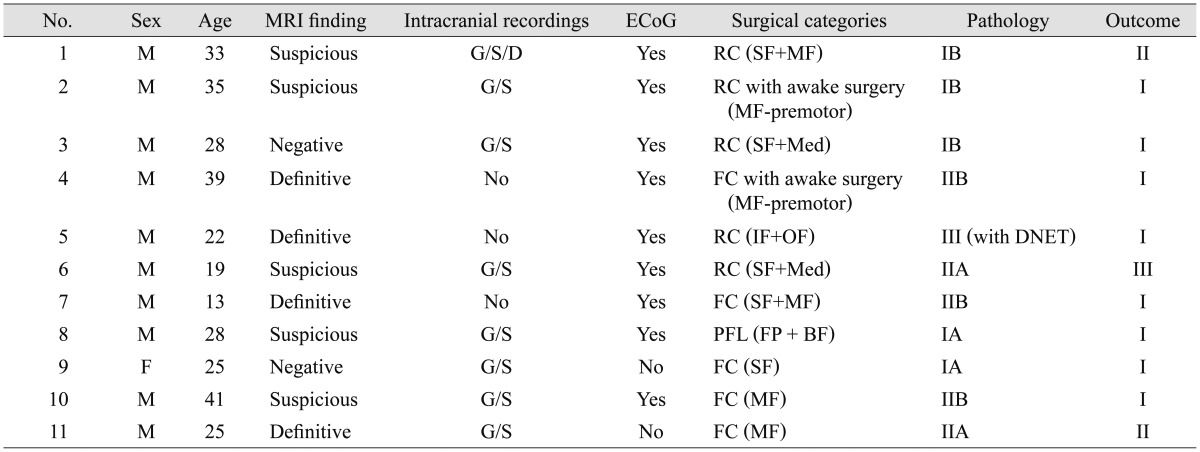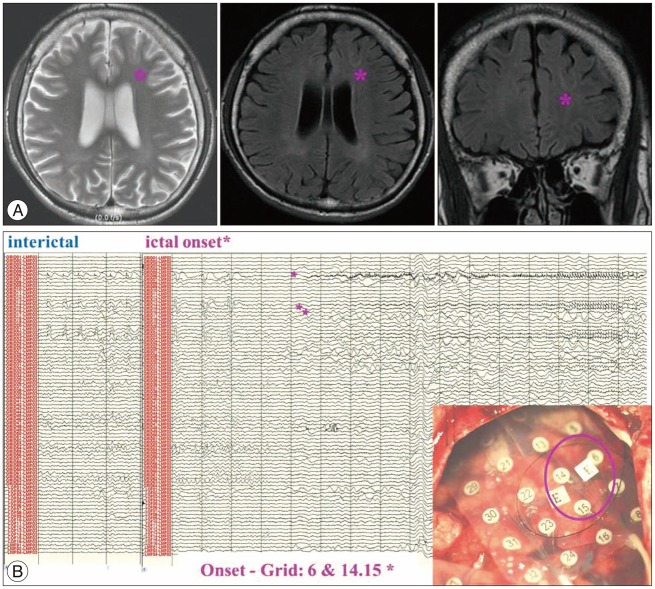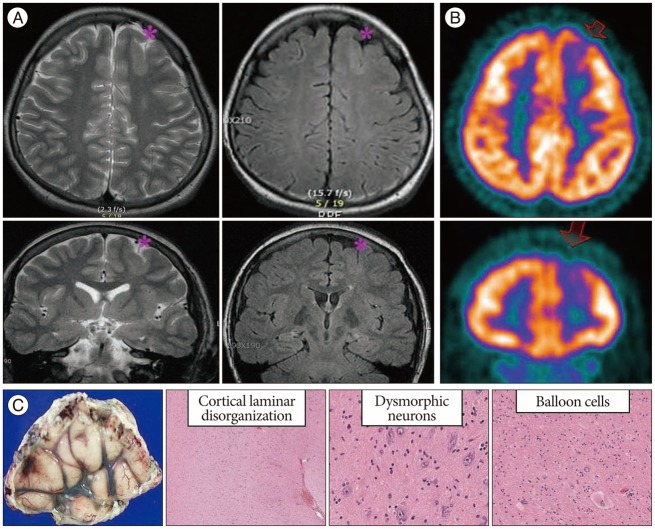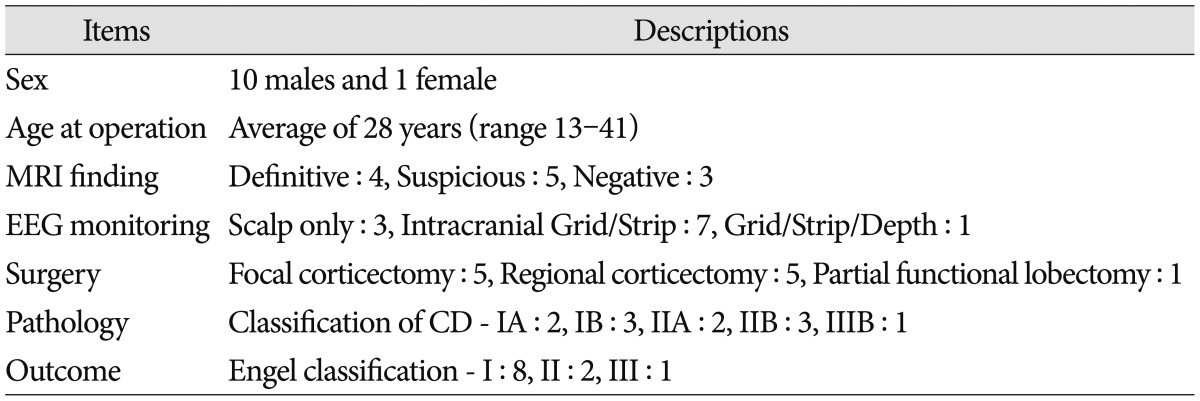1. Awad IA, Rosenfeld J, Ahl J, Hahn JF, Lüders H. Intractable epilepsy and structural lesions of the brain : mapping, resection strategies, and seizure outcome. Epilepsia. 1991; 32:179–186. PMID:
1900789.

2. Barkovich AJ, Kuzniecky RI. Neuroimaging of focal malformations of cortical development. J Clin Neurophysiol. 1996; 13:481–494. PMID:
8978620.

3. Bautista RE, Cobbs MA, Spencer DD, Spencer SS. Prediction of surgical outcome by interictal epileptiform abnormalities during intracranial EEG monitoring in patients with extrahippocampal seizures. Epilepsia. 1999; 40:880–890. PMID:
10403211.

4. Becker AJ, Blümcke I, Urbach H, Hans V, Majores M. Molecular neuropathology of epilepsy-associated glioneuronal malformations. J Neuropathol Exp Neurol. 2006; 65:99–108. PMID:
16462201.

5. Blümcke I, Thom M, Aronica E, Armstrong DD, Vinters HV, Palmini A, et al. The clinicopathologic spectrum of focal cortical dysplasias : a consensus classification proposed by an ad hoc Task Force of the ILAE Diagnostic Methods Commission. Epilepsia. 2011; 52:158–174. PMID:
21219302.

6. Bronen RA, Vives KP, Kim JH, Fulbright RK, Spencer SS, Spencer DD. Focal cortical dysplasia of Taylor, balloon cell subtype : MR differentiation from low-grade tumors. AJNR Am J Neuroradiol. 1997; 18:1141–1151. PMID:
9194442.
7. Chassoux F, Devaux B, Landré E, Turak B, Nataf F, Varlet P, et al. Stereoelectroencephalography in focal cortical dysplasia : a 3D approach to delineating the dysplastic cortex. Brain. 2000; 123(Pt 8):1733–1751. PMID:
10908202.

8. Cohen-Gadol AA, Ozduman K, Bronen RA, Kim JH, Spencer DD. Long-term outcome after epilepsy surgery for focal cortical dysplasia. J Neurosurg. 2004; 101:55–65. PMID:
15255252.

9. Davies KG, Weeks RD. Cortical resections for intractable epilepsy of extratemporal origin : experience with seventeen cases over eleven years. Br J Neurosurg. 1993; 7:343–353. PMID:
8216904.

10. Dubeau F, Palmini A, Fish D, Avoli M, Gambardella A, Spreafico R, et al. The significance of electrocorticographic findings in focal cortical dysplasia : a review of their clinical, electrophysiological and neurochemical characteristics. Electroencephalogr Clin Neurophysiol Suppl. 1998; 48:77–96. PMID:
9949777.
11. Engel J Jr, Van Ness PC, Rasmussen TB, Ojemann LM. Outcome with respect to epileptic seizures. In : Engel J, editor. Surgical treatment of the Epilepsies. ed 2. New York: Raven Press;1993. p. 609–621.
12. Englot DJ, Wang DD, Rolston JD, Shih TT, Chang EF. Rates and predictors of long-term seizure freedom after frontal lobe epilepsy surgery : a systematic review and meta-analysis. J Neurosurg. 2012; 116:1042–1048. PMID:
22304450.

13. Eriksson S, Malmgren K, Rydenhag B, Jönsson L, Uvebrant P, Nordborg C. Surgical treatment of epilepsy--clinical, radiological and histopathological findings in 139 children and adults. Acta Neurol Scand. 1999; 99:8–15. PMID:
9925233.

14. Gambardella A, Palmini A, Andermann F, Dubeau F, Da Costa JC, Quesney LF, et al. Usefulness of focal rhythmic discharges on scalp EEG of patients with focal cortical dysplasia and intractable epilepsy. Electroencephalogr Clin Neurophysiol. 1996; 98:243–249. PMID:
8641147.

15. Giulioni M, Rubboli G, Marucci G, Martinoni M, Volpi L, Michelucci R, et al. Seizure outcome of epilepsy surgery in focal epilepsies associated with temporomesial glioneuronal tumors : lesionectomy compared with tailored resection. J Neurosurg. 2009; 111:1275–1282. PMID:
19408976.

16. Gump WC, Skjei KL, Karkare SN. Seizure control after subtotal lesional resection. Neurosurg Focus. 2013; 34:E1. PMID:
23724833.

17. Hader WJ, Mackay M, Otsubo H, Chitoku S, Weiss S, Becker L, et al. Cortical dysplastic lesions in children with intractable epilepsy : role of complete resection. J Neurosurg. 2004; 100(2 Suppl Pediatrics):110–117. PMID:
14758938.

18. Harvey AS, Cross JH, Shinnar S, Mathern GW. ILAE Pediatric Epilepsy Surgery Survey Taskforce. Defining the spectrum of international practice in pediatric epilepsy surgery patients. Epilepsia. 2008; 49:146–155. PMID:
18042232.

19. Hashizume K, Kiriyama K, Kunimoto M, Maeda T, Tanaka T, Miyamoto A, et al. Correlation of EEG, neuroimaging and histopathology in an epilepsy patient with diffuse cortical dysplasia. Childs Nerv Syst. 2000; 16:75–79. PMID:
10663810.

20. Hauptman JS, Mathern GW. Surgical treatment of epilepsy associated with cortical dysplasia : 2012 update. Epilepsia. 2012; 53(Suppl 4):98–104. PMID:
22946727.

21. Hong SC, Kang KS, Seo DW, Hong SB, Lee M, Nam DH, et al. Surgical treatment of intractable epilepsy accompanying cortical dysplasia. J Neurosurg. 2000; 93:766–773. PMID:
11059656.

22. Jobst BC, Siegel AM, Thadani VM, Roberts DW, Rhodes HC, Williamson PD. Intractable seizures of frontal lobe origin : clinical characteristics, localizing signs, and results of surgery. Epilepsia. 2000; 41:1139–1152. PMID:
10999553.

23. Kabat J, Król P. Focal cortical dysplasia - review. Pol J Radiol. 2012; 77:35–43. PMID:
22844307.
24. Kloss S, Pieper T, Pannek H, Holthausen H, Tuxhorn I. Epilepsy surgery in children with focal cortical dysplasia (FCD) : results of long-term seizure outcome. Neuropediatrics. 2002; 33:21–26. PMID:
11930272.

25. Kral T, Kuczaty S, Blümcke I, Urbach H, Clusmann H, Wiestler OD, et al. Postsurgical outcome of children and adolescents with medically refractory frontal lobe epilepsies. Childs Nerv Syst. 2001; 17:595–601. PMID:
11685521.

26. Kuzniecky RI. Neuroimaging in pediatric epilepsy. Epilepsia. 1996; 37(Suppl 1):S10–S21. PMID:
8647047.

27. Lee MH, Son EI. Comparison between initial and recent surgical outcome of 15-year series of surgically remediable epilepsy. J Korean Neurosurg Soc. 2010; 48:230–235. PMID:
21082050.

28. Liava A, Francione S, Tassi L, Lo Russo G, Cossu M, Mai R, et al. Individually tailored extratemporal epilepsy surgery in children : anatomo-electro-clinical features and outcome predictors in a population of 53 cases. Epilepsy Behav. 2012; 25:68–80. PMID:
22902651.

29. Palmini A, Andermann F, Olivier A, Tampieri D, Robitaille Y. Focal neuronal migration disorders and intractable partial epilepsy : results of surgical treatment. Ann Neurol. 1991; 30:750–757. PMID:
1789692.

30. Rosenow F, Lüders HO, Dinner DS, Prayson RA, Mascha E, Wolgamuth BR, et al. Histopathological correlates of epileptogenicity as expressed by electrocorticographic spiking and seizure frequency. Epilepsia. 1998; 39:850–856. PMID:
9701375.

31. Seo IY, Son EI, Yi SD, Lee CY, Lee JC, Kim DW, et al. Coexistence of neoplasia and cortical dysplasia associated with intractable epilepsy : a clinical study of seven surgical patients and surgical strategies. J Korean Neurosurg Soc. 1998; 27:516–522.
32. Sinclair DB, Wheatley M, Snyder T. Frontal lobe epilepsy in childhood. Pediatr Neurol. 2004; 30:169–176. PMID:
15033198.

33. Sisodiya SM. Surgery for malformations of cortical development causing epilepsy. Brain. 2000; 123(Pt 6):1075–1091. PMID:
10825348.

34. Téllez-Zenteno JF, Dhar R, Wiebe S. Long-term seizure outcomes following epilepsy surgery : a systematic review and meta-analysis. Brain. 2005; 128:1188–1198. PMID:
15758038.

35. Vachhrajani S, de Ribaupierre S, Otsubo H, Ochi A, Weiss SK, Donner EJ, et al. Neurosurgical management of frontal lobe epilepsy in children. J Neurosurg Pediatr. 2012; 10:206–216. PMID:
22838737.

36. Weber JP, Silbergeld DL, Winn HR. Surgical resection of epileptogenic cortex associated with structural lesions. Neurosurg Clin N Am. 1993; 4:327–336. PMID:
8467218.









 PDF
PDF ePub
ePub Citation
Citation Print
Print




 XML Download
XML Download